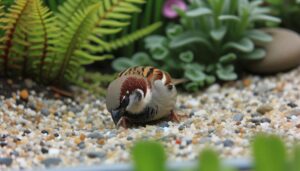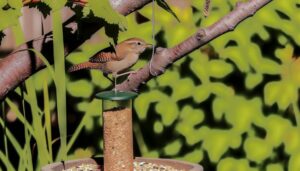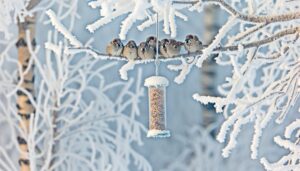Do You Want to Get Rid of House Sparrows Safely?
To effectively rid your home of house sparrows, start by eliminating food sources such as seeds, grains, and food scraps. Use sparrow-proof feeders, ensuring they restrict access only to sparrows.
Seal gaps in eaves, soffits, and other potential nesting sites with durable materials. Implement visual and audio deterrents like reflective tape and predator decoys to exploit sparrows' fear responses.
For humane trapping, place traps in high-traffic areas and relocate sparrows following local wildlife regulations. Finally, consistently maintain outdoor cleanliness and consider seeking professional expertise for sustainable control methods.
Further insights on the subject await.

Key Takeaways
- Remove food sources by securing garbage, cleaning feeding areas, and storing grains in sealed containers.
- Seal gaps and potential nesting sites in buildings using durable materials.
- Use sparrow-proof feeders and implement feeding restrictions to deter sparrows.
- Employ visual and audio deterrents like reflective tape, predator decoys, and distress calls.
- Capture and humanely relocate sparrows following local wildlife regulations.
Understand House Sparrow Behavior
Understanding the behavior of house sparrows (Passer domesticus) is vital for implementing effective control measures, as their social structure, feeding habits, and nesting preferences greatly influence their interactions with human environments.
These birds exhibit strong social bonds, often forming flocks that enhance their survival. They primarily feed on grains and seeds, but their diet can adapt to include insects and food scraps, which makes them highly opportunistic. Nesting preferences include cavities in buildings and other man-made structures, utilizing materials like grasses, feathers, and paper.
Remove Food Sources
Eliminating accessible food sources is a crucial step in controlling house sparrow populations and reducing their presence in human habitats. House sparrows are highly opportunistic feeders, thriving on a variety of food sources including seeds, grains, and discarded human food.
To effectively remove these attractants, make sure that bird feeders are emptied or moved, and regularly clean up spillage from feeding areas. Additionally, secure garbage bins with tight-fitting lids to prevent access to discarded food.
In agricultural settings, storing grains in sealed containers can greatly reduce food availability. Implementing these measures disrupts the food supply chain for house sparrows, making the habitat less welcoming and encouraging them to relocate.
This proactive approach is crucial for long-term sparrow management.
Install Sparrow-Proof Feeders
To effectively mitigate the presence of house sparrows, it is important to install sparrow-proof feeders. This involves selecting feeder designs that deter sparrows, implementing specific feeding restrictions, and employing exclusion techniques to limit access.
Choose Appropriate Feeder Design
Selecting a feeder design that specifically deters house sparrows while accommodating other bird species is crucial for maintaining a balanced avian ecosystem.
Effective sparrow-proof feeders often feature smaller perches that are challenging for house sparrows but suitable for smaller, less aggressive birds. In addition, tube feeders with short perches or mesh feeders can prevent sparrows from comfortably accessing the food.
Weight-sensitive feeders that close access ports under the weight of a house sparrow are another effective choice. Furthermore, feeders with adjustable baffles can be set to exclude sparrows.
Ensuring that the feeder design selectively restricts house sparrows while enabling other species to feed can notably reduce the sparrow population without adversely affecting more desirable bird species.
Implement Feeding Restrictions
Consistently implementing feeding restrictions through the installation of sparrow-proof feeders is an effective strategy to manage the presence of house sparrows while promoting a diverse avian community. Sparrow-proof feeders are specifically designed to exclude house sparrows due to their unique physical characteristics. These feeders typically feature smaller feeding ports and perches that limit access to larger birds, including house sparrows.
Additionally, weight-sensitive mechanisms can be employed to close access points when heavier birds attempt to feed. By selectively allowing access to smaller, desired bird species, these feeders contribute to a balanced ecosystem. Regularly cleaning and maintaining these feeders sustains their effectiveness and longevity, thereby supporting a sustainable approach to avian diversity and house sparrow management.
Use Exclusion Techniques
Building upon the strategy of implementing feeding restrictions, the next logical step involves utilizing exclusion techniques by installing sparrow-proof feeders to further control the presence of house sparrows. These feeders are designed to prevent access to sparrows while allowing other desirable bird species to feed. Key features include adjustable perches and weight-sensitive mechanisms that close feeding ports under the sparrow's weight.
| Feature | Description |
|---|---|
| Adjustable Perches | Perches can be shortened to deter sparrows. |
| Weight-Sensitive Ports | Closes under the weight of a sparrow. |
| Small Feeding Holes | Limits access to smaller birds only. |
| Baffle Systems | Prevents sparrows from clinging to the feeder. |
These exclusion techniques offer a scientifically sound method to selectively attract and sustain the desired avian population.
Exclude Nesting Sites
To effectively exclude nesting sites for house sparrows, it is crucial to seal any potential entry points and remove existing nests meticulously. House sparrows often exploit small openings and crevices to establish their nests, making thorough inspection and maintenance important.
Begin by identifying all possible entry points around your property, such as gaps in eaves, vents, or chimneys. Utilize durable materials to seal these openings, ensuring no space is left for sparrows to infiltrate. Additionally, regularly inspect and clear any existing nests to prevent reoccupation.
- Seal gaps in eaves and soffits with caulk or mesh.
- Install chimney caps to block entry.
- Use vent covers to secure ventilation openings.
- Regularly remove nests from gutters and ledges.
These steps will notably reduce the likelihood of sparrow infestations.
Use Visual and Audio Deterrents
Implementing visual and audio deterrents can disrupt the nesting and roosting behavior of house sparrows, thereby reducing their presence.
Visual deterrents such as reflective tape, predator decoys, and holographic devices create an environment perceived as unsafe by sparrows. These devices leverage the birds' instinctual fear response to unfamiliar or threatening stimuli.
Audio deterrents, including distress calls and ultrasonic devices, exploit the sparrows' acute hearing. Distress calls mimic the sounds of sparrows in danger, prompting them to avoid the area. Ultrasonic devices emit high-frequency sounds imperceptible to humans but disturbing to birds.
Both methods should be used consistently and in combination for maximum efficacy, ideally integrated into a complete pest management strategy.
Modify Landscaping
Altering your landscaping can greatly reduce the appeal of your property to house sparrows by minimizing potential nesting sites and food sources. Methodical modifications can considerably disrupt the habitat preferences of these birds.
Implementing the following changes can be particularly effective:
- Prune Dense Shrubs: Trim dense shrubs and trees to reduce potential nesting areas, as sparrows prefer thick foliage for nesting.
- Plant Native Species: Opt for native plants that do not produce the seeds or berries that house sparrows typically feed on.
- Limit Ground Cover: Minimize ground cover plants to deter foraging, as sparrows often search for food close to the ground.
- Utilize Mulch: Apply mulch around plants to cover seeds and deter sparrows from feeding and nesting in garden beds.
These strategic adaptations can help manage sparrow populations effectively.
Employ Humane Trapping Methods
For a methodical approach to managing house sparrow populations, employing humane trapping techniques can be both effective and ethical. Utilizing live traps, such as the funnel or repeating sparrow traps, allows for the safe capture of these birds without causing harm.
Place traps in areas where sparrows are frequently observed, using bait like grains or seeds to attract them. Regularly monitor and check the traps to guarantee birds are not left confined for extended periods.
Once captured, relocate the sparrows to a suitable habitat at a considerable distance from human habitation. It is essential to comply with local wildlife regulations and guidelines during this process, ensuring a balance between humane treatment and population control.
Conclusion
Effective management of house sparrows involves understanding their behavior and systematically removing food sources, installing sparrow-proof feeders, and excluding nesting sites.
Utilizing visual and audio deterrents, modifying landscaping, and employing humane trapping methods further aid in reducing their numbers.
Remarkably, a study found that modifying bird feeders reduced sparrow visits by up to 45%.
Implementing these strategies in a cohesive manner guarantees a significant decrease in house sparrow populations while maintaining ecological balance and humane treatment.






